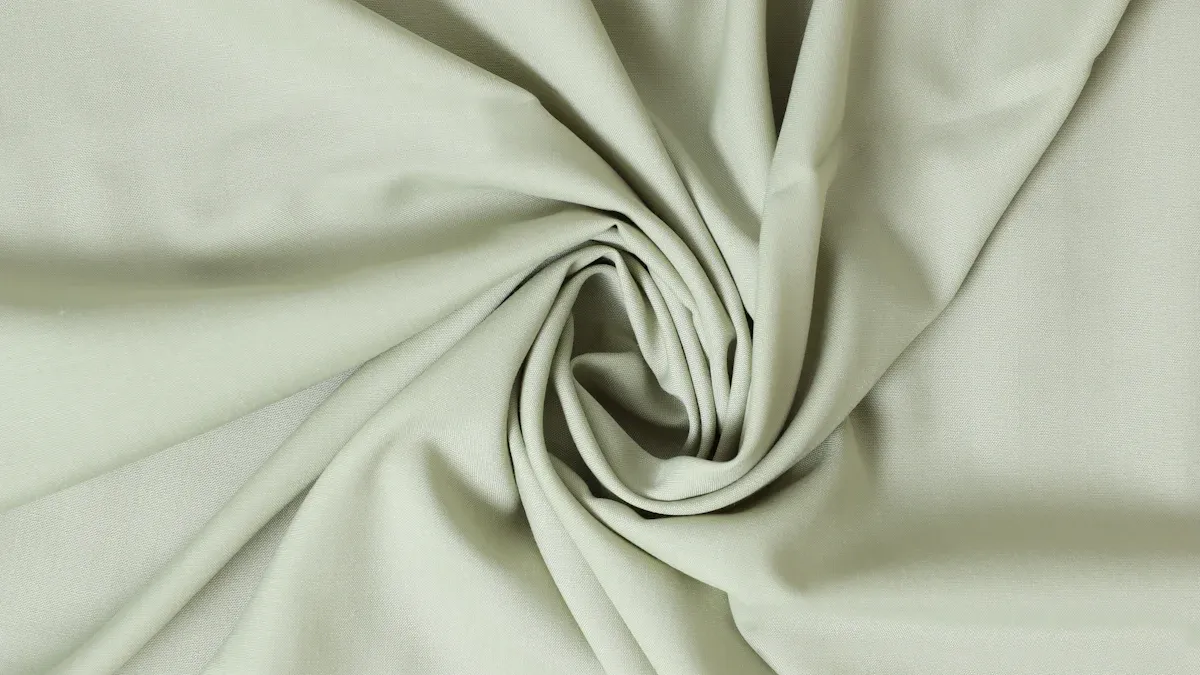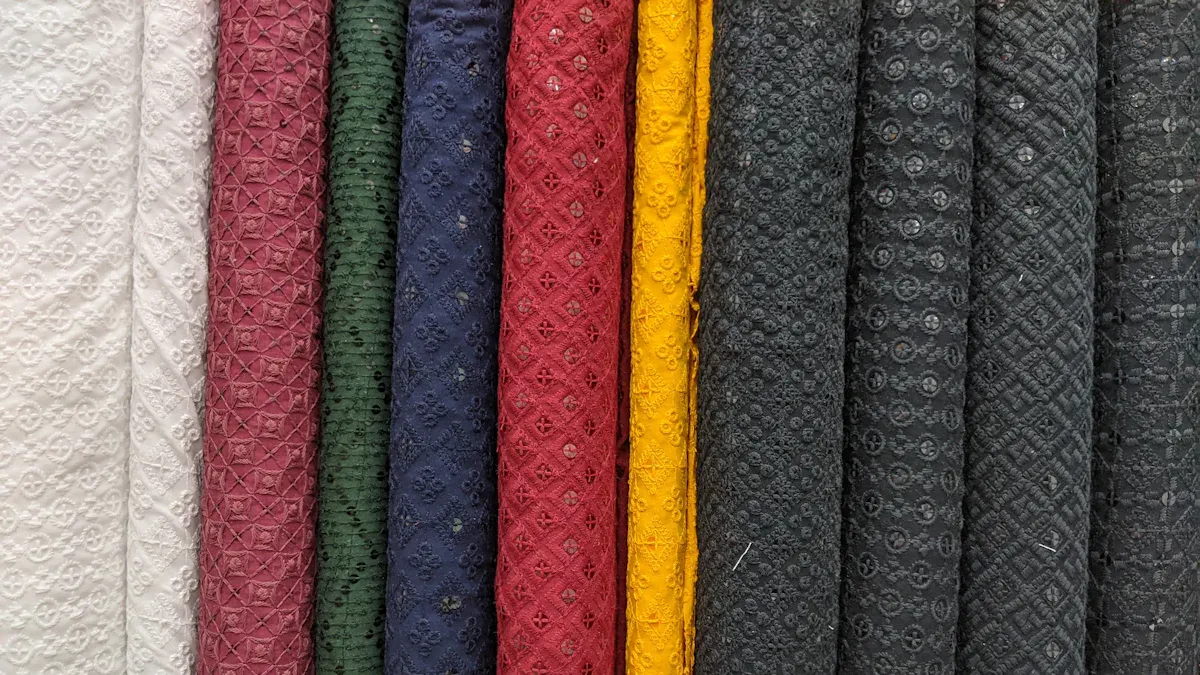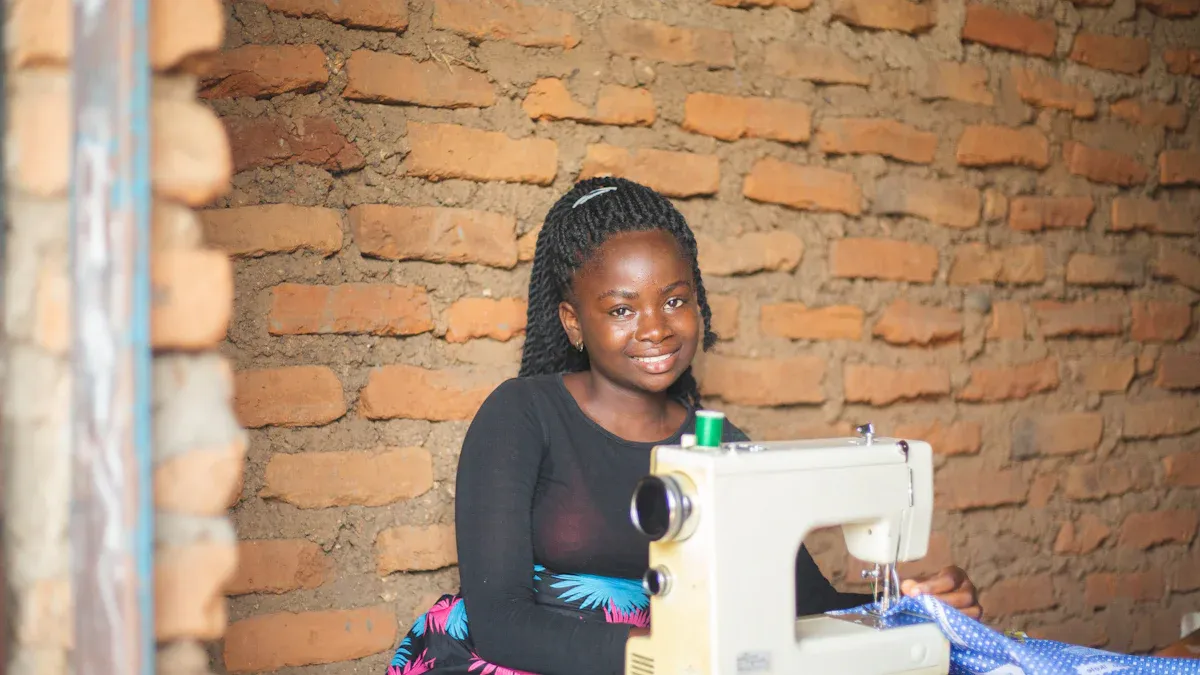
Scuba fabric offers a unique blend of stretch and structure, making it suitable for a wide range of creative projects. Makers at every skill level can personalize this material to suit their comfort and style preferences. Local shops and community experts provide valuable support, helping individuals achieve professional results with custom pieces.
Tip: Explore local resources for inspiration and guidance when working with scuba fabric.
Key Takeaways
- Scuba fabric combines stretch, structure, and durability, making it ideal for stylish and comfortable garments.
- Customizing scuba fabric lets you choose color, texture, thickness, and patterns to fit your unique design needs.
- Use sharp tools and proper sewing techniques like stretch needles and zigzag stitches for clean, lasting results.
- Care for scuba fabric gently by washing in cold water, air drying, and avoiding harsh chemicals to keep it vibrant and strong.
- Local fabric shops and tailors offer valuable support and resources to help you create professional custom pieces.
Scuba Fabric and Customization Benefits

What Makes Scuba Fabric Unique
Scuba fabric stands out for its remarkable combination of stretch, structure, and durability. Its double-knit construction provides a dense yet flexible feel, allowing garments to maintain their shape and resist wrinkles. Designers appreciate the smooth, spongy texture, which offers comfort against the skin and a polished appearance. The fabric’s four-way stretch ensures freedom of movement, making it suitable for both fashion and activewear.
Note: Scuba fabric’s excellent print reproduction allows for vibrant colors and sharp details, supporting creative custom projects.
A comparison of popular stretch fabrics highlights scuba fabric’s versatility:
| Fabric Type | Structure | Stretch | Texture | Best Uses |
|---|---|---|---|---|
| Scuba Crepe | Medium-weight, structured | High | Textured | Dresses, skirts, jackets |
| Neoprene | Heavy-weight, structured | Medium | Smooth | Wetsuits, protective gear |
| Jersey Knit | Lightweight, drapey | High | Smooth | T-shirts, casual dresses |
Scuba fabric’s durability, resistance to pilling and fading, and easy-care properties make it a preferred choice for everyday wear and travel. Its ability to withstand frequent washing and maintain its appearance sets it apart from other stretch fabrics.
Why Choose Custom Scuba Fabric
Custom scuba fabric offers designers and makers greater control over garment performance and aesthetics. The fabric’s polyester-spandex blend delivers firm support, shape retention, and comfort. Customization options include selecting fiber type, thickness, color, pattern, and texture, enabling tailored solutions for specific apparel needs.
Popular reasons for choosing custom scuba fabric include:
- High stretch and flexibility for a flattering fit
- Water resistance and quick drying for active lifestyles
- Ability to hold bold shapes, pleats, and smooth lines for modern designs
- Wrinkle resistance and durability for long-lasting wear
- Ease of printing custom patterns for personalized style
Custom scuba fabric’s structured thickness allows garments to be made without lining, supporting innovative design elements like ruffles and cutouts. The fabric’s moisture-wicking properties and soft feel enhance comfort, making it ideal for form-fitting dresses, hoodies, and pants. These features ensure that custom scuba fabric meets the demands of both fashion-forward and functional apparel projects.
Customization Options for Scuba FabricColor and Print Choices
Color and print selection plays a vital role in custom projects. Makers can choose from a wide spectrum of shades, ranging from classic neutrals to bold, vibrant hues. Digital printing technology allows for intricate patterns, gradients, and even photographic images to appear crisp and clear on scuba fabric. Local suppliers often offer swatch books or digital proofs, helping designers visualize the final result before production. Reviewing these samples ensures color accuracy and satisfaction with the finished product.
Tip: Always request a fabric swatch or digital proof to confirm color and print quality before placing a large order.
Thickness and Texture Selection
Thickness and texture influence both the appearance and performance of custom pieces. Scuba fabric comes in various weights, from lightweight for drapey garments to heavier options for structured designs. Texture selection impacts the final look and feel:
- Textured and luxurious fabrics, such as velvet or jacquard, add visual interest and flair.
- Smooth and silky options, like satin, create an elegant appearance but may require careful handling during sewing.
- Crisp and structured weaves, such as twill, help garments maintain a neat shape.
- Soft and cozy choices, including jersey, offer comfort and a relaxed style.
- Heavier textures provide durability and structure, while softer textures enhance tactile appeal.
Understanding the relationship between texture, weight, and project requirements helps makers achieve the desired aesthetic and functional qualities. Sampling different textures and reading detailed fabric descriptions support informed decisions.
Pattern and Design Personalization
Pattern and design personalization unlocks creative potential. Scuba fabric’s structure supports a variety of garment styles and techniques:
- Fit-and-flare dresses use the fabric’s body to create natural volume.
- Bodycon skirts benefit from thickness and stretch, offering a flattering fit.
- Peplum tops achieve a crisp, sculptural flare at the waist.
- Zip-up jackets feature high collars, exposed zippers, and color blocking for modern appeal.
- Wide-leg pants maintain shape and resist creasing.
- Sculptural skater skirts provide dramatic movement, ideal for special occasions.
- Statement sleeves, such as bell or ruffle styles, add volume and drama.
Designers often experiment with bold collars, asymmetrical hemlines, and raw or finished edges to enhance visual impact. Choosing patterns designed for stretch fabrics ensures the best fit and comfort.
Practical Tips for Customizing Scuba FabricSelecting the Right Scuba Fabric
Choosing the appropriate scuba fabric sets the foundation for a successful custom project. Makers should consider the intended use, desired structure, and comfort level. Thicker scuba fabrics provide more structure and support, making them ideal for garments that require volume, such as jackets or sculpted dresses. Thinner scuba fabrics offer greater flexibility and drape, which suits fitted tops, skirts, or activewear. Color, print, and texture options also play a role in the selection process. Reviewing swatches and reading detailed product descriptions help ensure the fabric meets both aesthetic and functional needs. For best results, select a fabric weight and finish that align with the garment’s purpose and the wearer’s comfort.
Tip: Always test a small sample for stretch, recovery, and feel before committing to a large purchase.
Cutting and Shaping Techniques
Accurate cutting and shaping techniques maintain the integrity of scuba fabric and ensure professional results. The following steps help achieve clean edges and precise shapes:
- Use sharp scissors or a rotary cutter to create smooth, clean cuts and minimize fraying.
- Immediately finish cut edges with a serger to secure and trim, preserving the fabric’s integrity.
- If a serger is unavailable, apply a zigzag stitch along the edges to prevent fraying.
- For small or vulnerable areas, use fray-checking glue sparingly to reinforce corners or seam edges.
- Stabilize the fabric before cutting by applying lightweight iron-on interfacing, which reduces edge fraying without adding bulk.
- Allow for wide seam allowances, at least 1/2 inch, to provide extra fabric for finishing and durability.
- Finish seam allowances with overlock or zigzag stitches to secure edges.
- For a sturdy and neat finish, encase raw edges with bias tape, adding durability and a professional appearance.
Shaping methods differ based on fabric thickness. Thick scuba fabric creates a structured silhouette and retains shape, making it suitable for bold collars, dramatic drapes, and full skirts. Seam trimming before overlocking reduces bulk, and a three-thread overlocker with the knife disengaged works best. Thin scuba fabric allows for more fitted, body-hugging shapes and better drape. Both types benefit from stretch needles and longer stitch lengths, but managing bulk is more critical for thicker fabrics.
Note: Always test cutting and shaping techniques on fabric scraps to refine your approach and avoid costly mistakes.
Sewing and Finishing Methods
Proper sewing and finishing methods prevent puckering and enhance the durability of custom scuba fabric items. The following steps ensure smooth seams and long-lasting results:
- Adjust thread tension to match the fabric’s weight, using lower tension for lighter fabrics and higher for heavier ones.
- Select the correct needle size and type, such as a ballpoint or stretch needle, to prevent skipped stitches and fabric damage.
- Use all-purpose polyester thread to avoid bulky seams.
- Test machine settings on scrap fabric before sewing the main project.
- Use a walking foot or dual feed to feed fabric layers evenly and prevent puckering.
- Lower presser foot pressure to reduce fabric distortion.
- Pin perpendicular to fabric edges and use clips for slippery fabrics to maintain alignment.
- Choose stretch stitches, such as a narrow zigzag, to allow seam flexibility and prevent seam popping.
- Grade seams to reduce bulk at seam allowances, helping seams lie flat.
- Press seams with a pressing cloth on the wrong side at low heat to avoid shiny marks or fabric damage.
Finishing techniques play a crucial role in enhancing durability, abrasion resistance, and moisture management. Advanced finishing processes optimize the fabric’s utility, texture, and color, supporting demanding uses and extending the lifespan of custom items. These steps ensure that garments not only look professional but also withstand regular wear and washing.
Callout: Investing time in proper sewing and finishing methods results in garments that maintain their shape, comfort, and appearance over time.
Caring for Custom Scuba Fabric
Proper care ensures custom projects retain their vibrant appearance, structure, and comfort over time. Many makers overlook essential maintenance steps, which can lead to premature wear and reduced durability. Following a consistent care routine preserves the fabric’s unique qualities and extends the lifespan of finished garments.
Tip: Gentle handling during every stage of use and cleaning protects the fabric’s integrity.
A well-maintained item resists fading, snags, and texture loss. The following best practices help maintain the quality of custom pieces:
- Avoid rough surfaces and sharp objects. These can cause snags or pulls that damage the fabric’s smooth finish.
- Wash by hand in cold water using a mild detergent. For machine washing, select a delicate cycle and place items in a mesh laundry bag to minimize abrasion.
- Air dry garments flat or hang them in a shaded area. Skip the dryer and keep items out of direct sunlight to prevent fading and preserve the fabric’s texture.
- Iron only when necessary, using low to medium heat and a pressing cloth. Avoid steam, which can alter the fabric’s structure.
- Store folded in a clean, dry space. This prevents accidental snags and keeps garments in optimal condition.
- Steer clear of bleach and harsh detergents. These substances can strip color and weaken fibers, leading to discoloration and reduced durability.
Note: Neglecting these steps often results in snags, fading, and loss of structure, which shortens the lifespan of custom projects.
Consistent care not only maintains the visual appeal of garments but also supports their performance and comfort. Makers who invest time in proper maintenance enjoy longer-lasting, high-quality results.
Local Resources for Scuba Fabric Customization

Finding Local Fabric Shops and Suppliers
Local fabric shops and specialty suppliers play a crucial role in sourcing materials for custom projects. These businesses often select wholesale manufacturers with strong quality management systems, such as ISO 9001 certification, and prioritize suppliers with Oeko-Tex credentials. They verify claims through third-party lab testing, virtual factory tours, and client references. Before making large purchases, they request fabric samples to inspect texture, thickness, and color. Staff at reputable stores, like Mood Fabrics or Spandex World, provide guidance on fabric selection and project suitability. Local suppliers also assess financial stability and responsiveness to ensure consistent supply. Customer reviews and ratings help identify reliable sources. Many shops offer purchasing options by the yard or in pre-cut pieces, allowing flexibility for different project sizes. Clear return policies and prompt communication support quality assurance and customer satisfaction.
Working with Local Tailors and Makers
Local tailors and makers bring expertise and hands-on involvement to custom fabric projects. They establish clear quality control measures, including inspection processes and defined benchmarks. Many negotiate agreements that include penalties for deviations from quality standards. Makers often begin with trial orders to evaluate reliability before committing to larger production runs. Regular audits and sample checks during production help maintain consistency. Open communication throughout the process ensures expectations are met. Direct engagement, such as reviewing swatches and testing threads, allows makers to refine materials and methods. This approach leads to high-quality, timely results and builds trust between clients and local professionals.
Tips for Collaborating with Community Experts
Effective collaboration with community experts enhances project outcomes. Traditional communication methods, such as word of mouth and trusted organizations, remain valuable for building relationships. Ongoing contact and feedback throughout the project foster positive experiences and sustained engagement. Involving multitasked coordinators or professional intermediaries can address challenges like task overload. Inclusive collaborations that respect local knowledge and co-design processes increase relevance and effectiveness. Mentorship programs and interdisciplinary approaches provide additional support and insight. Expanding the use of social networks and online platforms helps promote participation and share information widely. Sustained relationships and clear communication prevent misunderstandings and support successful, evolving collaborations.
Avoiding Common Scuba Fabric MistakesSizing and Fit Challenges
Many makers encounter sizing and fit issues when working with stretch fabrics. These challenges can affect comfort, appearance, and performance. The table below outlines common problems, their effects, and practical solutions:
| Sizing and Fit Challenge | Description and Effects | Common Solutions |
|---|---|---|
| Too Tight | Restricts movement, causes difficulty breathing and discomfort. | Size up, try different brands, stretch suit gently, break in suit. |
| Too Loose | Causes gaps, folds, air pockets, reduces thermal efficiency, may cause rashes. | Size down, custom fit, try different cuts or styles. |
| Uncomfortable Neck Area | Too tight or allows water entry, affecting comfort and usefulness. | Adjustable neck closures, try different brands, minor alterations. |
| Restrictive Shoulders and Arms | Limits overhead movement, critical for swimming and surfing. | Choose flexible neoprene, proper sizing, break in suit. |
| Baggy or Loose Lower Legs/Ankles | Leads to water flushing, reduces thermal efficiency. | Choose tighter fit, wetsuits with tighter seals/cuffs, minor alterations. |
To minimize sizing errors, makers should follow these steps:
- Take precise measurements with a flexible measuring tape, including all relevant dimensions.
- Refer to sizing charts or pattern guides for accuracy.
- Consider fabric width to determine yardage.
- Prewash fabric to account for shrinkage and add extra fabric as needed.
- Add a 10% to 20% allowance for seams, linings, or embellishments.
- For printed fabrics, add 0.5 to 1 yard for pattern matching.
- Double-check all measurements and calculations.
- Consult fabric store staff or specialists for tailored advice.
Tip: Accurate measurements and careful planning help prevent costly sizing mistakes.
Handling and Maintenance Errors
Improper handling and maintenance can reduce the lifespan and appearance of custom projects. Makers sometimes use rough tools or skip finishing steps, which leads to fraying or distortion. Washing items in hot water or using harsh detergents can cause fading and loss of structure. Air drying flat and storing garments in a clean, dry space preserves their quality. Gentle washing with mild detergent and low heat ironing with a pressing cloth protect the fabric’s integrity.
Note: Consistent care routines keep custom pieces looking and feeling their best.
Preventing Print and Color Issues
Print and color problems often arise from skipping sample checks or using incompatible inks. Colors may appear dull or misaligned if the printing process does not match the fabric’s properties. Makers should always request swatches or digital proofs before full production. Testing small sections ensures color accuracy and print clarity. Storing fabric away from direct sunlight and avoiding bleach helps maintain vibrant colors over time.
Callout: Early testing and proper storage prevent most print and color disappointments.
Customizing fabric for personal projects offers both simplicity and satisfaction. Beginners benefit from a material that resists fraying, stretches well, and holds vibrant colors. Key points for newcomers include:
- The fabric’s double-knit structure ensures durability and a neat finish.
- Smooth texture and water resistance provide comfort and style.
- Easy cutting and sewing make it accessible for all skill levels.
Local experts and practical tips help makers achieve professional results. Starting a custom project today brings creativity to life.
FAQ
What projects work best with scuba fabric?
Scuba fabric suits dresses, skirts, jackets, and activewear. Makers choose it for structured garments and bold designs. The fabric’s stretch and resilience support both fashion and functional items. Beginners and professionals use scuba fabric for its easy handling and vibrant print options.
How can someone find reliable local scuba fabric suppliers?
Local fabric shops often list suppliers online or in community directories. Staff recommend trusted sources based on quality and service. Visiting stores allows inspection of samples. Customer reviews and ratings help identify reliable suppliers. Makers benefit from direct communication with shop owners.
What sewing techniques improve results with scuba fabric?
Using a stretch needle and polyester thread prevents skipped stitches. A walking foot feeds layers evenly. Makers finish seams with zigzag or overlock stitches. Pressing seams with a cloth at low heat avoids shine. Testing settings on scraps ensures smooth sewing.
How should custom scuba fabric garments be cleaned?
Hand wash in cold water with mild detergent. Machine wash on delicate cycle using a mesh bag. Air dry flat or hang in shade. Avoid bleach and high heat. Store folded in a clean, dry space. Gentle care preserves color, texture, and structure.
Can scuba fabric be printed with custom designs?
Yes, digital printing produces vibrant colors and sharp details on scuba fabric. Makers request swatches or proofs before full production. Local suppliers offer printing services and guidance. Testing small sections ensures color accuracy. Proper storage maintains print quality over time.
Media Contact
Company Name: Shaoxing Suerte Textile Co., Ltd.
Email: Send Email
Phone: +86 13567212600
Address:Room 2303, Yuefun Tower, No.701 Jiefang Avenue
City: Shaoxing
State: Zhejiang
Country: China
Website: https://www.suertetextile.com/
